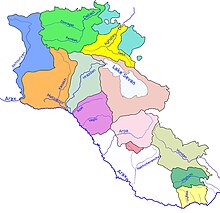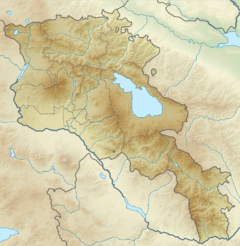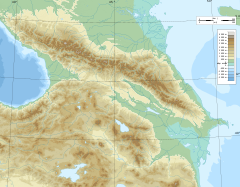geo.wikisort.org - River
The Vorotan (Armenian: Որոտան) or Bargushad (Azerbaijani: Bərgüşad) or Bazarchay (Azerbaijani: Bazarçay), is a river in Transcaucasia that is the largest right tributary of the Hakari river.[1] The river originates in the mountains of Azerbaijan's Kalbajar District and flows into Armenia's Syunik Province. It then flows through Armenia for 119 kilometres (74 mi) in a generally south-easterly direction. The river then enters Azerbaijan again, flowing for 43 km (27 mi) through the districts of Qubadli and Zangilan. The lower section of the Hakari, from its confluence with the Vorotan until its confluence with the Aras river, is sometimes considered to be part of the Vorotan.[2][3][4]
| Vorotan Bargushad, Bazarchay | |
|---|---|
 The Vorotan in Sisian | |
| Location | |
| Countries | Armenia and Azerbaijan |
| Physical characteristics | |
| Mouth | Hakari |
• coordinates | 39.2037°N 46.7170°E |
| Length | 162 km (101 mi) |
| Discharge | |
| • average | 21.5 m3/s (760 cu ft/s) |
| Basin features | |
| Progression | Hakari→ Aras→ Kura→ Caspian Sea |

Course of the river
The river mostly flows through mountainous country and in several places has formed deep canyons. The towns of Sisian and Qubadli lie along its course. Six kilometers from Sisian, the river forms a waterfall — the "Shaki Waterfall" (Armenian: Շաքիի ջրվեժ) — that is 18m high.[5] The river forms a natural monument — the "Devil's Bridge" — near Tatev Monastery. There are mineral pools at the base of the travertine arch.
Damming the river
During the Soviet period, three reservoirs forming the Vorotan Cascade were constructed. They supply Armenia with hydro-electric power and water for irrigation. To increase the volume of water in Lake Sevan, a 21.6-kilometre (13.4 mi) tunnel was constructed to abstract some of the Vorotan's waters and divert them to the lake.[6] Begun during the 1980s, work was stopped in 1988, when only 18 km (11 mi) had been completed, because of the outbreak of the First Nagorno-Karabakh War. The Armenian government finally completed the Vorotan tunnel in 2003. Prior to this, a second tunnel — "Arpa–Sevan" — was completed in 1981.[7] This diverts some water from the Arpa River for Lake Sevan. The waters coming through the two tunnels has resulted in the lake's water level rising. In 2007 it was reported that the water level had risen by 2.44 metres (8.0 ft) in the previous six years.[8]
Gallery
- The "Devil's Bridge" natural arch near Tatev Monastery
- The base of the "Devil's Bridge" 1 km from Goris
- Natural arch near Karahunj village on the Goris-Kapan highway above the river
- The Vorotan flowing through Qubadli District
References
- "Հագարի" [Hagari]. Dictionary of toponyms of Armenia and adjacent regions (in Armenian). Vol. 3. Yerevan: Yerevan University Publishing House. 2001. p. 299.
- "Армянский министр: Истоки двух основных рек Воротан и Арпа, питающих озеро Севан, находятся в карабахском районе Карвачар (Кельбаджар), который после войны перешел под контроль Азербайджана - Новости". dialogorg.ru. 26 January 2021. Retrieved 17 June 2022.
- Воротан, Great Soviet Encyclopedia
- "Rivers of Armenia". Armenia Discovery. Retrieved July 6, 2021.
- armsoul.com - Շաքիի ջրվեժ
- "1995-2003 "Complex of Hydraulic Structures for Diversion of the Vorotan River Runoff to the Basin of the Arpa River"". Arpa-Sevan. Archived from the original on 2022-08-11.
- "1961-1981 the Complex of Hydraulic Works for Transfer of the Arpa and Yeghegis". Arpa-Sevan. Archived from the original on 2022-08-11.
- Harutyunyan, Arpi (29 June 2007). "Sevan Rising: Lake Sevan's recovery quicker than expected". ArmeniaNow.
На других языках
[de] Worotan
Der Worotan (armenisch Որոտան, in wissenschaftl. Transliteration Orotan, aserbaidschanisch Bazarçay) ist ein Fluss im Transkaukasus.- [en] Vorotan (river)
[it] Vorotan
Il fiume Vorotan (Որոտան in armeno) è un fiume della Transcaucasia, affluente destro dell'Hakari che a sua volta è affluente sinistro del fiume Aras e sub-affluente del Kura.[ru] Воротан
Ворота́н (арм. Որոտան), Баргюшад[1] (азерб. Bərgüşad) или Базарчай (азерб. Bazarçay) — река в Закавказье, правый приток Акеры[2][3]. Протекает по территории Армении и Азербайджана. Длина — 178 км, из них 119 км в Армении, 59 — в Азербайджане. Воротан является горной рекой, на отдельных участках протекает по глубоким каньонам, уклон — 16 метров на 1 километр.Другой контент может иметь иную лицензию. Перед использованием материалов сайта WikiSort.org внимательно изучите правила лицензирования конкретных элементов наполнения сайта.
WikiSort.org - проект по пересортировке и дополнению контента Википедии







